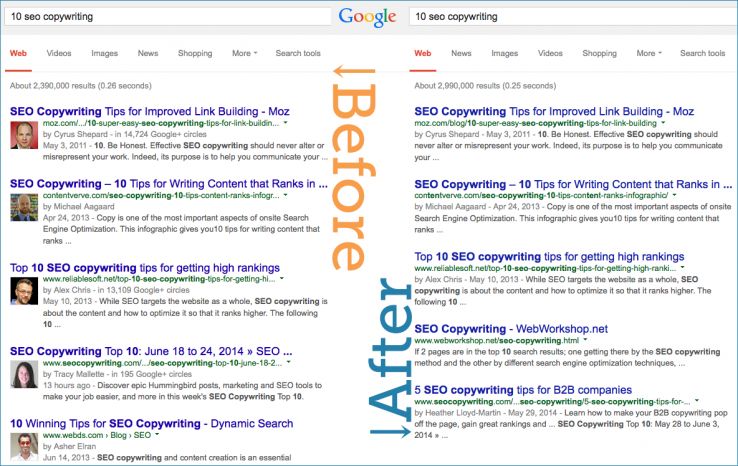In the past 2 months Google made big changes to its search results.
Webmasters saw disappearing Google authorship photos, reduced video snippets, changes to local packs and in-depth articles, and more.
Here at Moz, we’ve closely monitored our own URLs to measure the effect of these changes on our actual traffic. The results surprised us.
Authorship traffic—surprising results
In the early days of authorship, many webmasters worked hard to get their photo in Google search results. I confess, I doubt anyone worked harder at author snippets than me.
Search results soon became crowded with smiling faces staring back at us. Authors hired professional photographers. Publishers worked to correctly follow Google’s guidelines to set up authorship for thousands of authors.
The race for more clicks was on.
Then on June 28th, Google cleared the page. No more author photos.
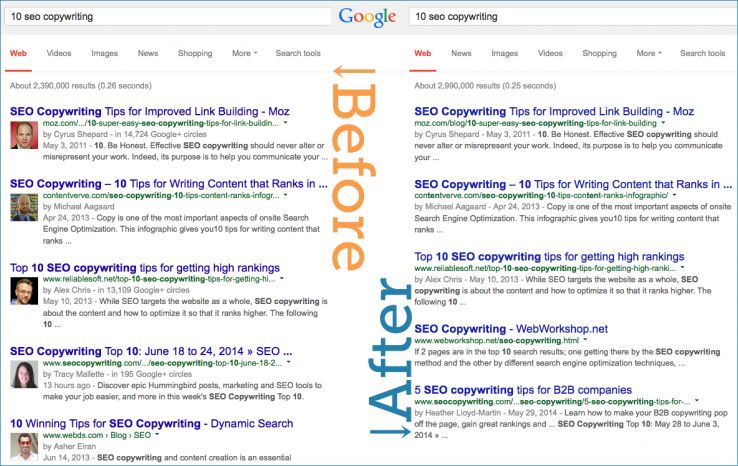
To gauge the effect on traffic, we examined eight weeks’ worth of data from Google Analytics and Webmaster Tools, before and after the change. We then examined our top 15 authorship URLs (where author photos were known to show consistently) compared to non-authorship URLs.
The results broke down like this:
Change in Google organic traffic to Moz
- Total Site: -1.76%
- Top 15 Non-Authorship URLs: -5.96%
- Top 15 Authorship URLs: -2.86%
Surprisingly, authorship URLs performed as well as non-authorship URLs in terms of traffic. Even though Moz was highly optimized for authors, traffic didn’t significantly change.
On an individual level, things looked much different. We actually observed big changes in traffic with authorship URLs increasing or decreasing in traffic by as much as 45%. There is no clear pattern: Some went up, some went down—exactly like any URL would over an extended time.
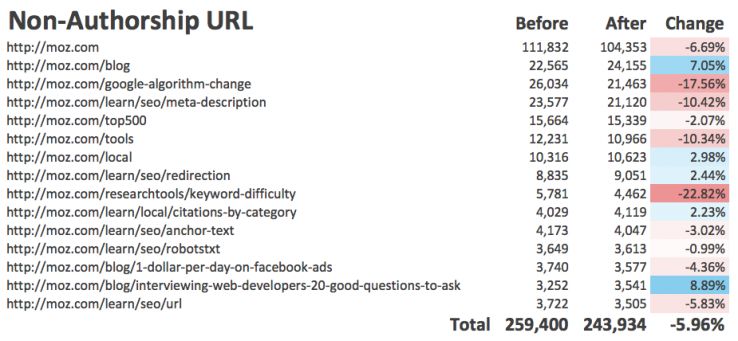
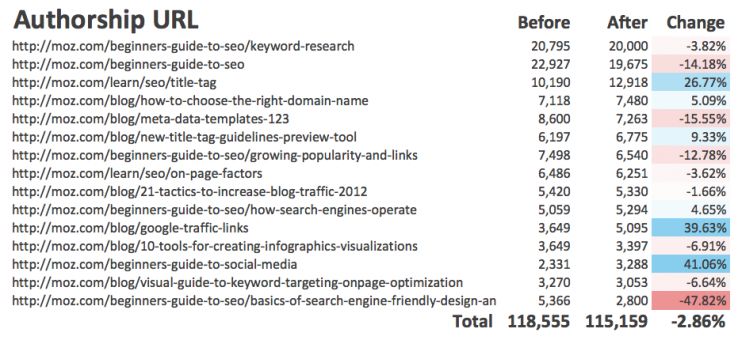
Authorship photos don’t exist in a vacuum; each photo on the page competed for attention with all the other photos on the page.
Each search result is as unique as a fingerprint. What worked for one result didn’t work for another.
Consider what happens visually when multiple author photos exist in the same search result:
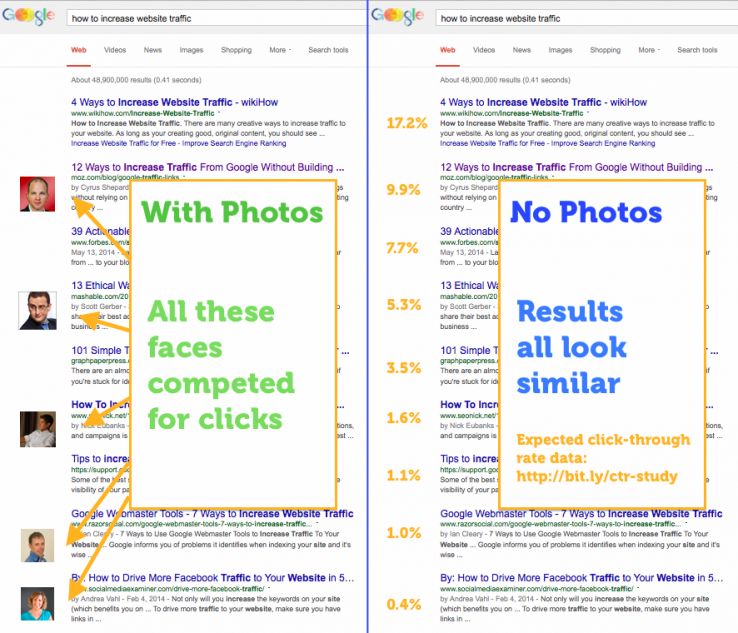
One hypothesis speculates that more photos has the effect of drawing eyes down the page. In the absence of rich snippets, search click-through rates might follow more closely studied models, which dictate that results closer to the top earn more clicks.
In the absence of author photos, it’s likely click-through rate expectations have once again become more standardized.
Video snippets: a complex tale
Shortly after Google removed author photos, they took aim at video snippets as well. On July 17th, MozCast reported a sharp decline in video thumbnails.
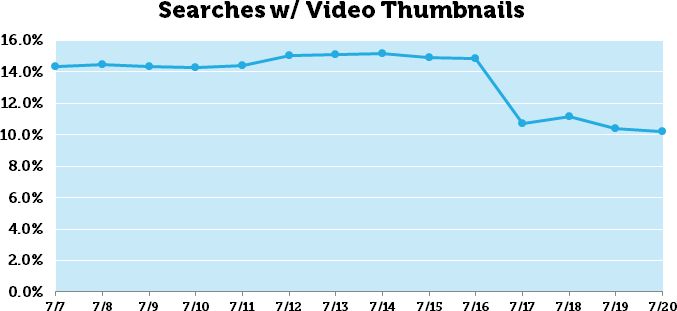
Most sites, Moz included, lost 100% of their video results. Other sites appeared to be “white-listed” as reported by former Mozzer Casey Henry at Wistia.
A few of the sites Casey found where Google continues to show video thumbnails:
- youtube.com
- vimeo.com
- vevo.com
- ted.com
- today.com
- discovery.com
Aside from these “giants,” most webmasters, even very large publishers at the top of the industry, saw their video snippets vanish in search results.
How did this loss affect traffic for our URLs with embedded videos? Fortunately, here at Moz we have a large collection of ready-made video URLs we could easily study: our Whiteboard Friday videos, which we produce every, well, Friday.
To our surprise, most URLs actually saw more traffic.
On average, our Whiteboard Friday videos saw a 10% jump in organic traffic after losing video snippets.

A few other with video saw dramatic increases:
The last example, the Learn SEO page, didn’t have an actual video on it, but a bug with Google caused them to display an older video thumbnail. (Several folks we’ve talked to speculate that Google removed video snippets simply to clean up their bugs in the system)
We witnessed a significant increase in traffic after losing video snippets. How did this happen?
Did Google change the way they rank and show video pages?
It turns out that many of our URLs that contained videos also saw a significant change in the number of search impressions at the exact same time.
According to Google, impressions for the majority of our video URLs shot up dramatically around July 14th.



Impressions for Whiteboard Friday URLs also rose 20% during this time. For Moz, most of the video URLs saw many more impressions, but for others, it appears rankings dropped.
While Moz saw video impressions rise, other publishers saw the opposite effect.
Casey Henry, our friend at video hosting company Wistia, reports seeing rankings drop for many video URLs that had thin or little content.
“…it’s only pages hosting video with thin content… the pages that only had video and a little bit of text went down.”
– Casey Henry
For a broader perspective, we talked to Marshall Simmonds, founder of Define Media Group, who monitors traffic to millions of daily video pageviews for large publishers.
Marshall found that despite the fact that most of the sites they monitor lost video snippets, they observed no visible change in either traffic or pageviews across hundreds of millions of visits.
Define Media Group also recently released its 2014 Mid-Year Digital Traffic Report which sheds fascinating light on current web traffic trends.
What does it all mean?
While we have anecdotal evidence of ranking and impression changes for video URLs on individual sites, on the grand scale across all Google search results these differences aren’t visible.
If you have video content, the evidence suggests it’s now worth more than ever to follow video SEO best practices: (taken from video SEO expert Phil Nottingham)
- Use a crawlable player (all the major video hosting platforms use these today)
- Surround the video with supporting information (caption files and transcripts work great)
- Include schema.org video markup
SEO finds a way
For the past several years web marketers competed for image and video snippets, and it’s with a sense of sadness that they’ve been taken away.
The smart strategy follows the data, which suggest that more traditional click-through rate optimization techniques and strategies could now be more effective. This means strong titles, meta descriptions, rich snippets (those that remain), brand building and traditional ranking signals.
What happened to your site when Google removed author photos and video snippets? Let us know in the comments below.

